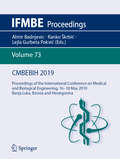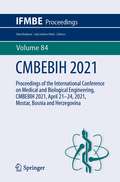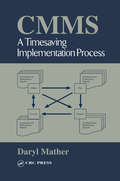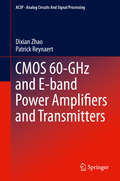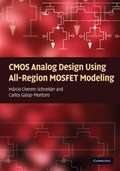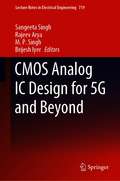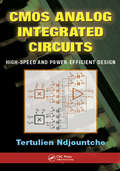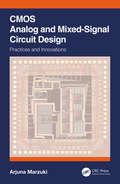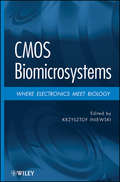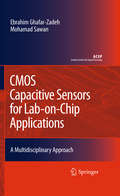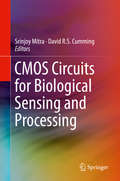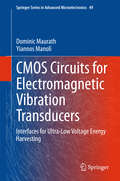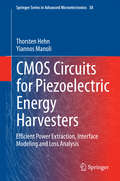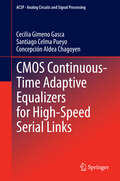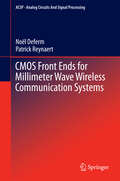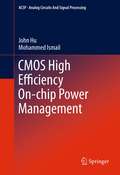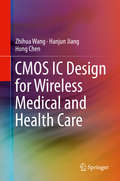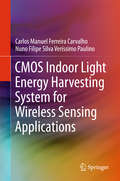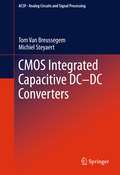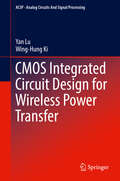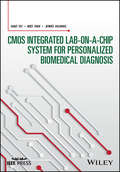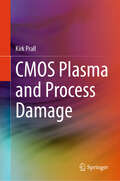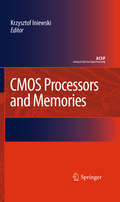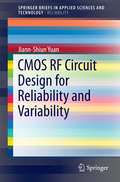- Table View
- List View
CLEAN: CO2 Large-Scale Enhanced Gas Recovery in the Altmark Natural Gas Field - GEOTECHNOLOGIEN Science Report No. 19 (Advanced Technologies in Earth Sciences)
by Ute Münch Michael KühnThe project CLEAN (CO2 Large-Scale Enhanced Gas Recovery in the Altmark Natural Gas Field) provides site specific knowledge for a potential future pilot project. This contributed volume gives an overview and final results of the entire project which is finalized to the end of 2012.
CMBEBIH 2019: Proceedings of the International Conference on Medical and Biological Engineering, 16 ̶̶ 18 May 2019, Banja Luka, Bosnia and Herzegovina (IFMBE Proceedings #73)
by Almir Badnjevic Ranko Škrbić Lejla Gurbeta PokvićThis volume gathers the proceedings of the International Conference on Medical and Biological Engineering, which was held from 16 to 18 May 2019 in Banja Luka, Bosnia and Herzegovina. Focusing on the goal to ‘Share the Vision’, it highlights the latest findings, innovative solutions and emerging challenges in the field of Biomedical Engineering. The book covers a wide range of topics, including: biomedical signal processing, medical physics, biomedical imaging and radiation protection, biosensors and bioinstrumentation, bio-micro/nano technologies, biomaterials, biomechanics, robotics and minimally invasive surgery, and cardiovascular, respiratory and endocrine systems engineering. Further topics include bioinformatics and computational biology, clinical engineering and health technology assessment, health informatics, e-health and telemedicine, artificial intelligence and machine learning in healthcare, as well as pharmaceutical and genetic engineering. Given its scope, the book provides academic researchers, clinical researchers and professionals alike with a timely reference guide to measures for improving the quality of life and healthcare.
CMBEBIH 2021: Proceedings of the International Conference on Medical and Biological Engineering, CMBEBIH 2021, April 21–24, 2021, Mostar, Bosnia and Herzegovina (IFMBE Proceedings #84)
by Almir Badnjevic Lejla Gurbeta PokvićThis book presents cutting-edge research and developments in the field of medical and biological engineering. It gathers the proceedings of the International Conference on Medical and Biological Engineering, CMBEBIH 2021, held partly virtually, partly physically, on April 21–24, 2021, from and in Mostar, Bosnia and Herzegovina. Focusing on the goal to ‘Stay Focused’, contributions report on both basic and applied research in a wide range of related fields, such as biomedical signal processing, medical physics and imaging, biosensors and micro/nanotechnologies, biomaterials, biomechanics and robotics, cardiorespiratory, endocrine and neural systems engineering. Novel models, methods and technologies for bio- and health informatics, as well as applications of machine learning and AI in health care, and advances in genetic engineering are also highlighted. All in all, this book provides academics and professionals with novel, practical solutions to solve the current problems in biomedical research and applications, and a source of inspiration for improving medicine and health care in the future.
CMMS: A Timesaving Implementation Process (Plant Engineering Series)
by Daryl MatherA prevalent system in large corporations for quite some time, Computerized Maintenance Management System (CMMS) is now penetrating moderate to small corporations on an international level. These corporations need an efficient method to implement this effective but complicated system. However, most of the texts currently available are written by the
CMOS 60-GHz and E-band Power Amplifiers and Transmitters (Analog Circuits and Signal Processing)
by Patrick Reynaert Dixian ZhaoThis book focuses on the development of design techniques and methodologies for 60-GHz and E-band power amplifiers and transmitters at device, circuit and layout levels. The authors show the recent development of millimeter-wave design techniques, especially of power amplifiers and transmitters, and presents novel design concepts, such as "power transistor layout" and "4-way parallel-series power combiner", that can enhance the output power and efficiency of power amplifiers in a compact silicon area. Five state-of-the-art 60-GHz and E-band designs with measured results are demonstrated to prove the effectiveness of the design concepts and hands-on methodologies presented. This book serves as a valuable reference for circuit designers to develop millimeter-wave building blocks for future 5G applications.
CMOS Analog Design Using All-Region MOSFET Modeling
by Márcio Cherem Schneider Carlos Galup-MontoroComparing bipolar technology briefly but otherwise not considering it, Schneider and Galup-Montoro (both electrical engineering, Federal U. of Santa Catarina, Brazil) focus on analog MOS (metal-oxide-semiconductor) circuits at the transistor level. They use an accurate but simple MOS transistor model for design, in order to reduce the distance between hand design and simulation results. Instead of the usual separate analytical formulas for the strong-inversion and weak-inversion operation regions of a building block, they provide simple formulas that are valid in all operation regions, including moderate inversion. The unified design is particularly suitable for analog design in advanced complementary MOS (CMOS) technologies. Among their topics are temporal and spatial fluctuations in MOSFETs (MOS field-effect-transistors), current mirrors, basic gain stages, operational amplifiers, and fundamentals of sampled-data circuits. The text is suitable for analog CMOS design courses. Annotation ©2010 Book News, Inc. , Portland, OR (booknews. com)
CMOS Analog IC Design for 5G and Beyond (Lecture Notes in Electrical Engineering #719)
by Brijesh Iyer Rajeev Arya Sangeeta Singh M. P. SinghThis book is focused on addressing the designs of FinFET-based analog ICs for 5G and E-band communication networks. In addition, it also incorporates some of the contemporary developments over different fields. It highlights the latest advances, problems and challenges and presents the latest research results in the field of mm-wave integrated circuits designing based on scientific literature and its practical realization. The traditional approaches are excluded in this book. The authors cover various design guidelines to be taken care for while designing these circuits and detrimental scaling effects on the same. Moreover, Gallium Nitrides (GaN) are also reported to show huge potentials for the power amplifier designing required in 5G communication network. Subsequently, to enhance the readability of this book, the authors also include real-time problems in RFIC designing, case studies from experimental results, and clearly demarking design guidelines for the 5G communication ICs designing. This book incorporates the most recent FinFET architecture for the analog IC designing and the scaling effects along with the GaN technology as well.
CMOS Analog Integrated Circuits: High-Speed and Power-Efficient Design
by Tertulien NdjountcheHigh-speed, power-efficient analog integrated circuits can be used as standalone devices or to interface modern digital signal processors and micro-controllers in various applications, including multimedia, communication, instrumentation, and control systems. New architectures and low device geometry of complementary metaloxidesemiconductor (CMOS) technologies have accelerated the movement toward system on a chip design, which merges analog circuits with digital, and radio-frequency components. CMOS: Analog Integrated Circuits: High-Speed and Power-Efficient Design describes the important trends in designing these analog circuits and provides a complete, in-depth examination of design techniques and circuit architectures, emphasizing practical aspects of integrated circuit implementation. Focusing on designing and verifying analog integrated circuits, the author reviews design techniques for more complex components such as amplifiers, comparators, and multipliers. The book details all aspects, from specification to the final chip, of the development and implementation process of filters, analog-to-digital converters (ADCs), digital-to-analog converters (DACs), phase-locked loops (PLLs), and delay-locked loops (DLLs). It also describes different equivalent transistor models, design and fabrication considerations for high-density integrated circuits in deep-submicrometer process, circuit structures for the design of current mirrors and voltage references, topologies of suitable amplifiers, continuous-time and switched-capacitor circuits, modulator architectures, and approaches to improve linearity of Nyquist converters. The text addresses the architectures and performance limitation issues affecting circuit operation and provides conceptual and practical solutions to problems that can arise in the design process. This reference provides balanced coverage of theoretical and practical issues that will allow the reader to design CMOS analog integrated circuits with improved electrical performance. The chapters contain easy-to-follow mathematical derivations of all equations and formulas, graphical plots, and open-ended design problems to help determine most suitable architecture for a given set of performance specifications. This comprehensive and illustrative text for the design and analysis of CMOS analog integrated circuits serves as a valuable resource for analog circuit designers and graduate students in electrical engineering.
CMOS Analog and Mixed-Signal Circuit Design: Practices and Innovations
by Arjuna MarzukiThe purpose of this book is to provide a complete working knowledge of the Complementary Metal-Oxide Semiconductor (CMOS) analog and mixed-signal circuit design, which can be applied for System on Chip (SOC) or Application-Specific Standard Product (ASSP) development. It begins with an introduction to the CMOS analog and mixed-signal circuit design with further coverage of basic devices, such as the Metal-Oxide Semiconductor Field-Effect Transistor (MOSFET) with both long- and short-channel operations, photo devices, fitting ratio, etc. Seven chapters focus on the CMOS analog and mixed-signal circuit design of amplifiers, low power amplifiers, voltage regulator-reference, data converters, dynamic analog circuits, color and image sensors, and peripheral (oscillators and Input/Output [I/O]) circuits, and Integrated Circuit (IC) layout and packaging. Features: Provides practical knowledge of CMOS analog and mixed-signal circuit design Includes recent research in CMOS color and image sensor technology Discusses sub-blocks of typical analog and mixed-signal IC products Illustrates several design examples of analog circuits together with layout Describes integrating based CMOS color circuit
CMOS Biomicrosystems
by Krzysztof IniewskiThe book will address the-state-of-the-art in integrated Bio-Microsystems that integrate microelectronics with fluidics, photonics, and mechanics. New exciting opportunities in emerging applications that will take system performance beyond offered by traditional CMOS based circuits are discussed in detail. The book is a must for anyone serious about microelectronics integration possibilities for future technologies. The book is written by top notch international experts in industry and academia. The intended audience is practicing engineers with electronics background that want to learn about integrated microsystems. The book will be also used as a recommended reading and supplementary material in graduate course curriculum.
CMOS Capacitive Sensors for Lab-on-Chip Applications: A Multidisciplinary Approach (Analog Circuits and Signal Processing)
by Mohamad Sawan Ebrahim Ghafar-ZadehThe main components of CMOS capacitive biosensors including sensing electrodes, bio-functionalized sensing layer, interface circuitries and microfluidic packaging are verbosely explained in chapters 2-6 after a brief introduction on CMOS based LoCs in Chapter 1. CMOS Capacitive Sensors for Lab-on-Chip Applications is written in a simple pedagogical way. It emphasises practical aspects of fully integrated CMOS biosensors rather than mathematical calculations and theoretical details. By using CMOS Capacitive Sensors for Lab-on-Chip Applications, the reader will have circuit design methodologies, main important biological capacitive interfaces and the required microfluidic fabrication procedures to create capacitive biosensor through standard CMOS process.
CMOS Circuits for Biological Sensing and Processing
by Srinjoy Mitra David R. S. CummingThis book provides the most comprehensive and consistent survey of the field of IC design for Biological Sensing and Processing. The authors describe a multitude of applications that require custom CMOS IC design and highlight the techniques in analog and mixed-signal circuit design that potentially can cross boundaries and benefit the very wide community of bio-medical engineers.
CMOS Circuits for Electromagnetic Vibration Transducers: Interfaces for Ultra-Low Voltage Energy Harvesting (Springer Series in Advanced Microelectronics #49)
by Yiannos Manoli Dominic MaurathChip-integrated power management solutions are a must for ultra-low power systems. This enables not only the optimization of innovative sensor applications. It is also essential for integration and miniaturization of energy harvesting supply strategies of portable and autonomous monitoring systems. The book particularly addresses interfaces for energy harvesting, which are the key element to connect micro transducers to energy storage elements. Main features of the book are: - A comprehensive technology and application review, basics on transducer mechanics, fundamental circuit and control design, prototyping and testing, up to sensor system supply and applications. - Novel interfacing concepts - including active rectifiers, MPPT methods for efficient tracking of DC as well as AC sources, and a fully-integrated charge pump for efficient maximum AC power tracking at sub-100aeW ultra-low power levels. The chips achieve one of widest presented operational voltage range in standard CMOS technology: 0. 44V to over 4. 1V. - Two special chapters on analog circuit design ? it studies benefits and obstacles on implemented chip prototypes with three goals: ultra- low power, wide supply voltage range, and integration with standard technologies. Alternative design approaches are pursued using bulk-input transistor stages in forward-bias operation for amplifiers, modulators, and references. - Comprehensive Appendix ? with additional fundamental analysis, design and scaling guidelines, circuit implementation tables and dimensions, schematics, source code listings, bill of material, etc. The discussed prototypes and given design guidelines are tested with real vibration transducer devices. The intended readership is graduate students in advanced courses, academics and lecturers, R&D engineers.
CMOS Circuits for Piezoelectric Energy Harvesters: Efficient Power Extraction, Interface Modeling and Loss Analysis (Springer Series in Advanced Microelectronics #38)
by Yiannos Manoli Thorsten HehnThis book deals with the challenge of exploiting ambient vibrational energy which can be used to power small and low-power electronic devices, e. g. wireless sensor nodes. Generally, particularly for low voltage amplitudes, low-loss rectification is required to achieve high conversion efficiency. In the special case of piezoelectric energy harvesting, pulsed charge extraction has the potential to extract more power compared to a single rectifier. For this purpose, a fully autonomous CMOS integrated interface circuit for piezoelectric generators which fulfills these requirements is presented. Due to these key properties enabling universal usage, other CMOS designers working in the field of energy harvesting will be encouraged to use some of the shown structures for their own implementations. The book is unique in the sense that it highlights the design process from scratch to the final chip. Hence, it gives the designer a comprehensive guide of how to (i) setup an appropriate harvester model to get realistic simulation results, (ii) design the integrated circuits for low power operation, (iii) setup a laboratory measurement environment in order to extensively characterize the chip in combination with the real harvester and finally, (iv) interpret the simulation/measurement results in order to improve the chip performance. Since the dimensions of all devices (transistors, resistors etc. ) are given, readers and other designers can easily re-use the presented circuit concepts.
CMOS Continuous-Time Adaptive Equalizers for High-Speed Serial Links (Analog Circuits and Signal Processing #130)
by Santiago Celma Pueyo Cecilia Gimeno Gasca Concepción Aldea ChagoyenThis book introduces readers to the design of adaptive equalization solutions integrated in standard CMOS technology for high-speed serial links. Since continuous-time equalizers offer various advantages as an alternative to discrete-time equalizers at multi-gigabit rates, this book provides a detailed description of continuous-time adaptive equalizers design - both at transistor and system levels-, their main characteristics and performances. The authors begin with a complete review and analysis of the state of the art of equalizers for wireline applications, describing why they are necessary, their types, and their main applications. Next, theoretical fundamentals of continuous-time adaptive equalizers are explored. Then, new structures are proposed to implement the different building blocks of the adaptive equalizer: line equalizer, loop-filters, power comparator, etc. The authors demonstrate the design of a complete low-power, low-voltage, high-speed, continuous-time adaptive equalizer. Finally, a cost-effective CMOS receiver which includes the proposed continuous-time adaptive equalizer is designed for 1. 25 Gb/s optical communications through 50-m length, 1-mm diameter plastic optical fiber (POF).
CMOS Front Ends for Millimeter Wave Wireless Communication Systems (Analog Circuits and Signal Processing)
by Patrick Reynaert Noël DefermThis book focuses on the development of circuit and system design techniques for millimeter wave wireless communication systems above 90GHz and fabricated in nanometer scale CMOS technologies. The authors demonstrate a hands-on methodology that was applied to design six different chips, in order to overcome a variety of design challenges. Behavior of both actives and passives, and how to design them to achieve high performance is discussed in detail. This book serves as a valuable reference for millimeter wave designers, working at both the transistor level and system level.
CMOS High Efficiency On-chip Power Management (Analog Circuits and Signal Processing)
by Mohammed Ismail John HuThis book will introduce various power management integrated circuits (IC) design techniques to build future energy-efficient "green" electronics. The goal is to achieve high efficiency, which is essential to meet consumers' growing need for longer battery lives. The focus is to study topologies amiable for full on-chip implementation (few external components) in the mainstream CMOS technology, which will reduce the physical size and the manufacturing cost of the devices.
CMOS IC Design for Wireless Medical and Health Care
by Hong Chen Zhihua Wang Hanjun JiangThis book provides readers with detailed explanation of the design principles of CMOS integrated circuits for wireless medical and health care, from the perspective of two successfully-commercialized applications. Design techniques for both the circuit block level and the system level are discussed, based on real design examples. CMOS IC design techniques for the entire signal chain of wireless medical and health care systems are covered, including biomedical signal acquisition, wireless transceivers, power management and SoC integration, with emphasis on ultra-low-power IC design techniques.
CMOS Indoor Light Energy Harvesting System for Wireless Sensing Applications
by Carlos Manuel Ferreira Carvalho Nuno Filipe Silva Veríssimo PaulinoThis book discusses in detail the CMOS implementation of energy harvesting. The authors describe an integrated, indoor light energy harvesting system, based on a controller circuit that dynamically and automatically adjusts its operation to meet the actual light circumstances of the environment where the system is placed. The system is intended to power a sensor node, enabling an autonomous wireless sensor network (WSN). Although designed to cope with indoor light levels, the system is also able to work with higher levels, making it an all-round light energy harvesting system. The discussion includes experimental data obtained from an integrated manufactured prototype, which in conjunction with a photovoltaic (PV) cell, serves as a proof of concept of the desired energy harvesting system.
CMOS Integrated Capacitive DC-DC Converters (Analog Circuits and Signal Processing #0)
by Michiel Steyaert Tom Van BreussegemThis book provides a detailed analysis of all aspects of capacitive DC-DC converter design: topology selection, control loop design and noise mitigation. Readers will benefit from the authors' systematic overview that starts from the ground up, in-depth circuit analysis and a thorough review of recently proposed techniques and design methodologies. Not only design techniques are discussed, but also implementation in CMOS is shown, by pinpointing the technological opportunities of CMOS and demonstrating the implementation based on four state-of-the-art prototypes.
CMOS Integrated Circuit Design for Wireless Power Transfer (Analog Circuits and Signal Processing)
by Yan Lu Wing-Hung KiThis book presents state-of-the-art analog and power management IC design techniques for various wireless power transfer (WPT) systems. To create elaborate power management solutions, circuit designers require an in-depth understanding of the characteristics of each converter and regulator in the power chain. This book addresses WPT design issues at both system- and circuit-level, and serves as a handbook offering design insights for research students and engineers in the integrated power electronics area.
CMOS Integrated Lab-on-a-chip System for Personalized Biomedical Diagnosis (Wiley - IEEE)
by Mei Yan Hao Yu Xiwei HuangA thorough examination of lab-on-a-chip circuit-level operations to improve system performance A rapidly aging population demands rapid, cost-effective, flexible, personalized diagnostics. Existing systems tend to fall short in one or more capacities, making the development of alternatives a priority. CMOS Integrated Lab-on-a-Chip System for Personalized Biomedical Diagnosis provides insight toward the solution, with a comprehensive, multidisciplinary reference to the next wave of personalized medicine technology. A standard complementary metal oxide semiconductor (CMOS) fabrication technology allows mass-production of large-array, miniaturized CMOS-integrated sensors from multi-modal domains with smart on-chip processing capability. This book provides an in-depth examination of the design and mechanics considerations that make this technology a promising platform for microfluidics, micro-electro-mechanical systems, electronics, and electromagnetics. From CMOS fundamentals to end-user applications, all aspects of CMOS sensors are covered, with frequent diagrams and illustrations that clarify complex structures and processes. Detailed yet concise, and designed to help students and engineers develop smaller, cheaper, smarter lab-on-a-chip systems, this invaluable reference: Provides clarity and insight on the design of lab-on-a-chip personalized biomedical sensors and systems Features concise analyses of the integration of microfluidics and micro-electro-mechanical systems Highlights the use of compressive sensing, super-resolution, and machine learning through the use of smart SoC processing Discusses recent advances in complementary metal oxide semiconductor-integrated lab-on-a-chip systems Includes guidance on DNA sequencing and cell counting applications using dual-mode chemical/optical and energy harvesting sensors The conventional reliance on the microscope, flow cytometry, and DNA sequencing leaves diagnosticians tied to bulky, expensive equipment with a central problem of scale. Lab-on-a-chip technology eliminates these constraints while improving accuracy and flexibility, ushering in a new era of medicine. This book is an essential reference for students, researchers, and engineers working in diagnostic circuitry and microsystems.
CMOS Plasma and Process Damage
by Kirk PrallThis book discusses the complex technology of building CMOS computer chips and covers some of the unusual problems that can occur during chip manufacturing. Readers will learn how plasma and process damage results from the high-energy processes that are used in chip manufacturing, causing harm to the chips, functional failure and reliability problems.
CMOS Processors and Memories (Analog Circuits and Signal Processing)
by Krzysztof IniewskiCMOS Processors and Memories addresses the-state-of-the-art in integrated circuit design in the context of emerging computing systems. New design opportunities in memories and processor are discussed. Emerging materials that can take system performance beyond standard CMOS, like carbon nanotubes, graphene, ferroelectrics and tunnel junctions are explored. CMOS Processors and Memories is divided into two parts: processors and memories. In the first part we start with high performance, low power processor design, followed by a chapter on multi-core processing. They both represent state-of-the-art concepts in current computing industry. The third chapter deals with asynchronous design that still carries lots of promise for future computing needs. At the end we present a "hardware design space exploration" methodology for implementing and analyzing the hardware for the Bayesian inference framework. This particular methodology involves: analyzing the computational cost and exploring candidate hardware components, proposing various custom architectures using both traditional CMOS and hybrid nanotechnology CMOL. The first part concludes with hybrid CMOS-Nano architectures. The second, memory part covers state-of-the-art SRAM, DRAM, and flash memories as well as emerging device concepts. Semiconductor memory is a good example of the full custom design that applies various analog and logic circuits to utilize the memory cell's device physics. Critical physical effects that include tunneling, hot electron injection, charge trapping (Flash memory) are discussed in detail. Emerging memories like FRAM, PRAM and ReRAM that depend on magnetization, electron spin alignment, ferroelectric effect, built-in potential well, quantum effects, and thermal melting are also described. CMOS Processors and Memories is a must for anyone serious about circuit design for future computing technologies. The book is written by top notch international experts in industry and academia. It can be used in graduate course curriculum.
CMOS RF Circuit Design for Reliability and Variability (SpringerBriefs in Applied Sciences and Technology)
by Jiann-Shiun YuanThe subject of this book is CMOS RF circuit design for reliability. The device reliability and process variation issues on RF transmitter and receiver circuits will be particular interest to the readers in the field of semiconductor devices and circuits. This proposed book is unique to explore typical reliability issues in the device and technology level and then to examine their impact on RF wireless transceiver circuit performance. Analytical equations, experimental data, device and circuit simulation results will be given for clear explanation. The main benefit the reader derive from this book will be clear understanding on how device reliability issues affects the RF circuit performance subjected to operation aging and process variations.

